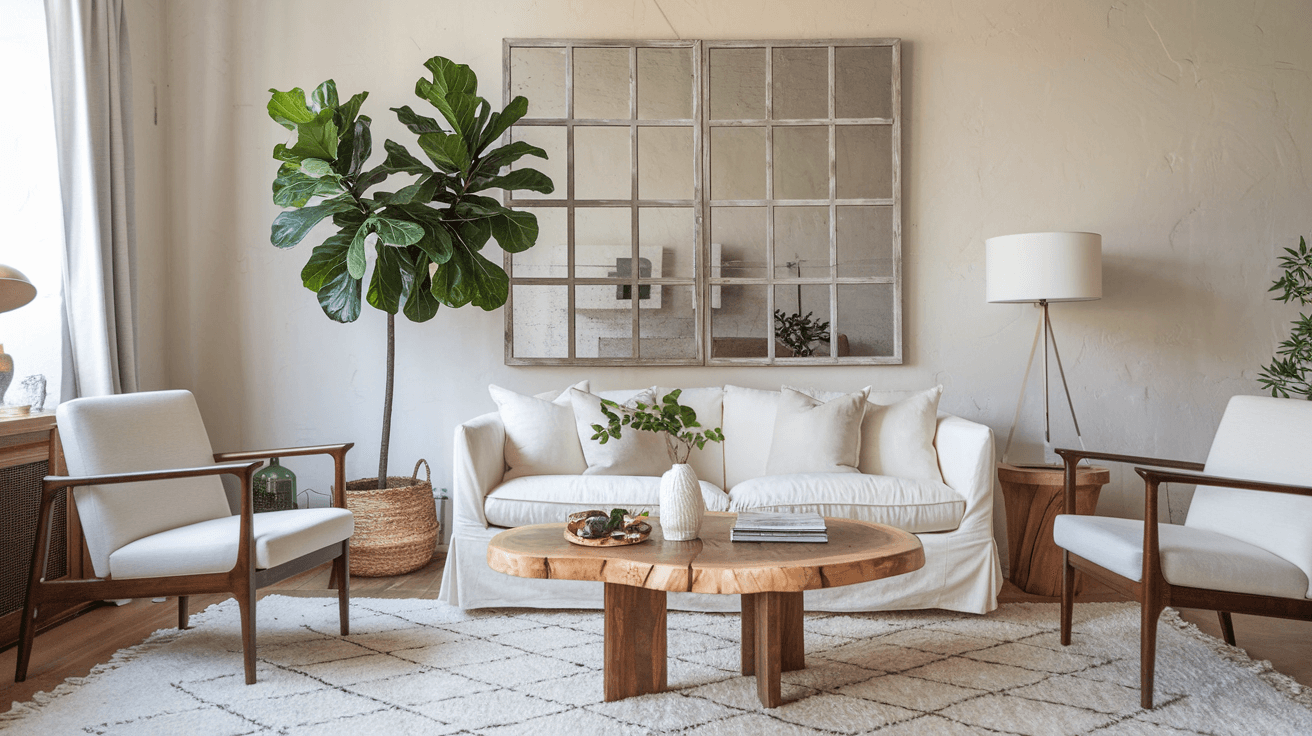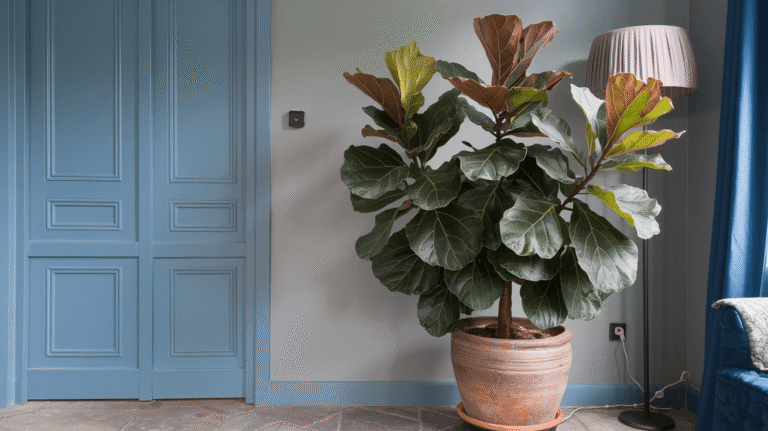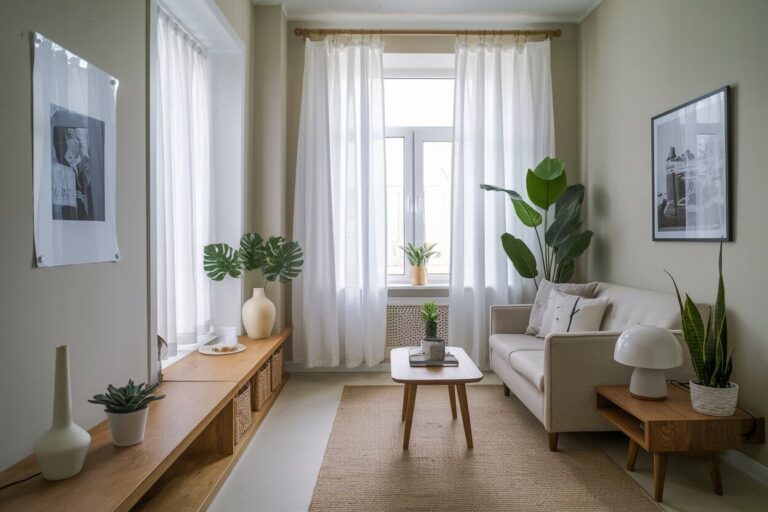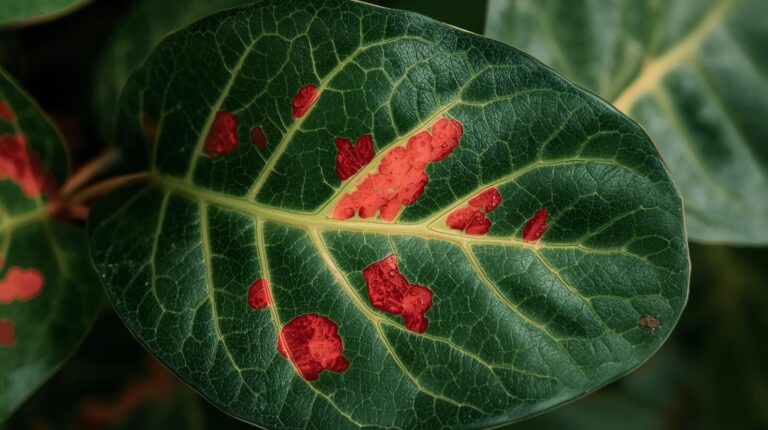The fiddle leaf fig has become more than just a houseplant—it’s practically a lifestyle statement, appearing in design magazines, home tours, and countless Instagram feeds.
But beyond the aesthetic appeal that’s made these plants so trendy, fiddle leaf figs offer genuine, science-backed benefits that improve both living spaces and the wellbeing of those who inhabit them.
I’ve maintained multiple fiddles over the years and noticed tangible differences in rooms where they’re placed—better air quality, improved humidity, and an undeniable psychological boost from caring for and living alongside these impressive plants. What surprises many new fiddle owners is that the benefits extend far beyond decoration.
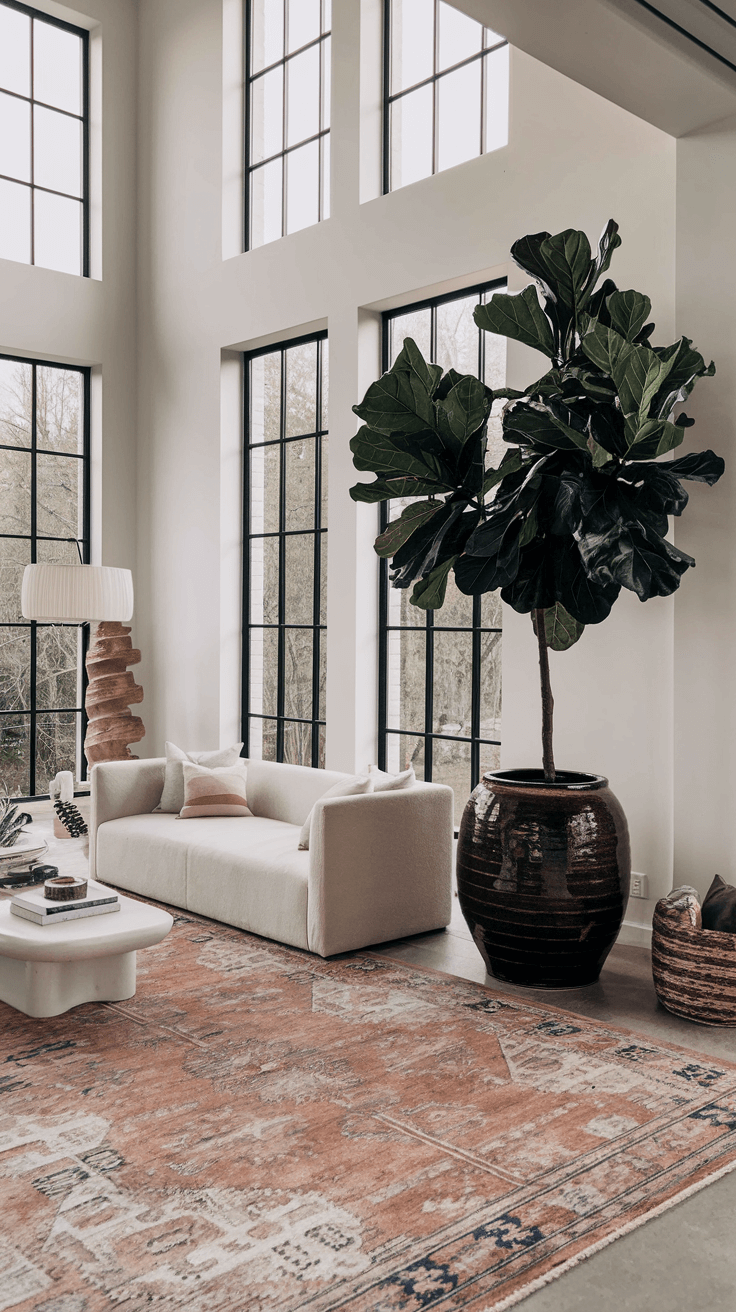
These plants actively contribute to healthier indoor environments while providing opportunities for stress reduction, skill development, and connecting with nature despite urban living constraints.
This guide explores ten compelling reasons why bringing a fiddle leaf fig into your home represents an investment in both your space and your quality of life, from measurable environmental improvements to the subtle psychological advantages that emerge from nurturing living things.
Air Purification and Oxygen Production
Fiddle leaf figs actively filter common indoor air pollutants through their large, broad leaves. Like all plants, they absorb carbon dioxide and release oxygen through photosynthesis, but their substantial leaf surface area makes them particularly efficient at this gas exchange.
A mature fiddle with 30-40 large leaves can process significantly more air than smaller houseplants, making a measurable difference in rooms where people spend extended time.
Why it works: The large fiddle leaves function as natural air filters, capturing airborne particles and absorbing volatile organic compounds (VOCs) commonly released by furniture, carpets, and household products.
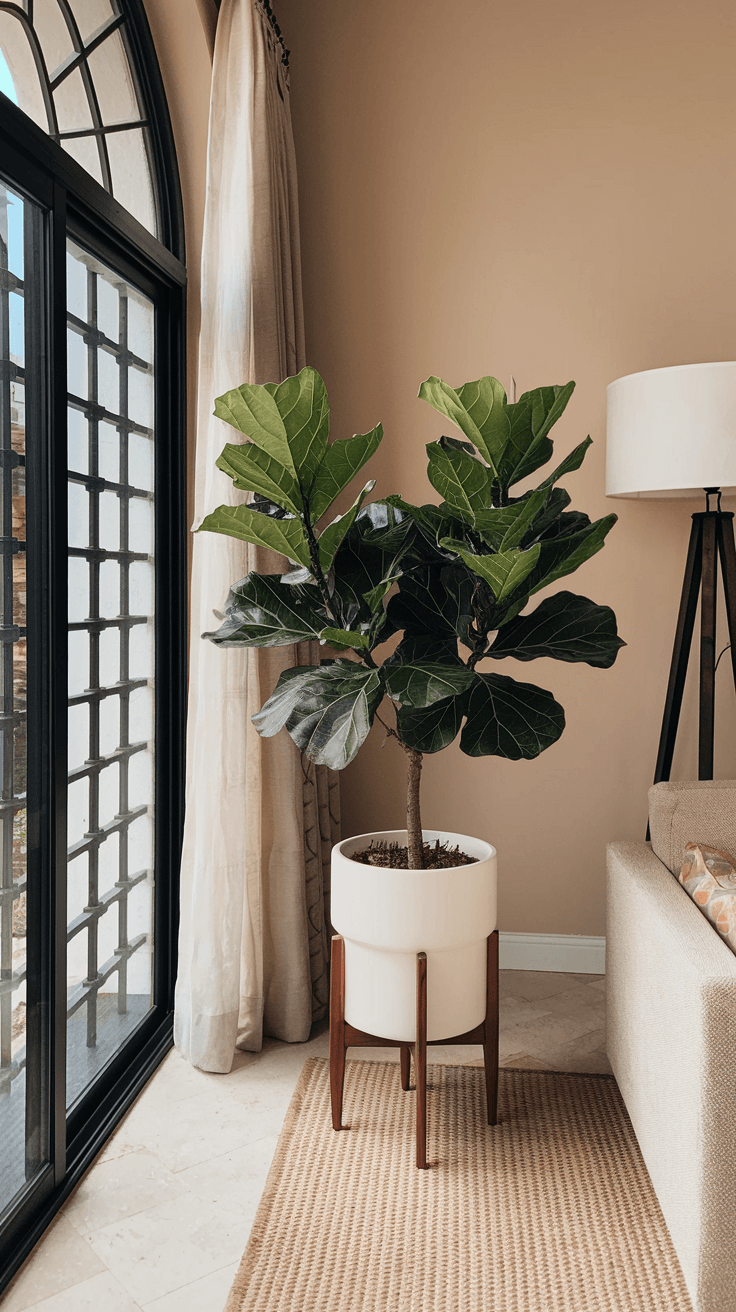
Studies on ficus species have demonstrated their effectiveness at removing formaldehyde, benzene, and trichloroethylene from indoor air.
Best for: Home offices, bedrooms, and living spaces where you spend several hours daily and want to improve air quality naturally without mechanical filtration systems.
Pro tip: Position your fiddle in rooms with new furniture or fresh paint, where VOC levels tend to be highest. The plant works continuously to reduce these compounds over time.
Quick implementation: Place a mature fiddle (4+ feet tall) in your bedroom to benefit from nighttime oxygen production while you sleep, creating a fresher morning environment.
Natural Humidity Regulation
Fiddle leaf figs release moisture into the air through transpiration, the process by which water drawn through roots evaporates from leaf surfaces.
A large fiddle can release several cups of water into the air daily, functioning as a natural humidifier that doesn’t require electricity or maintenance beyond regular watering.
Why it works: The substantial surface area of fiddle leaves combined with active transpiration means these plants add meaningful moisture to dry indoor air, particularly during winter when heating systems reduce humidity to uncomfortable levels.
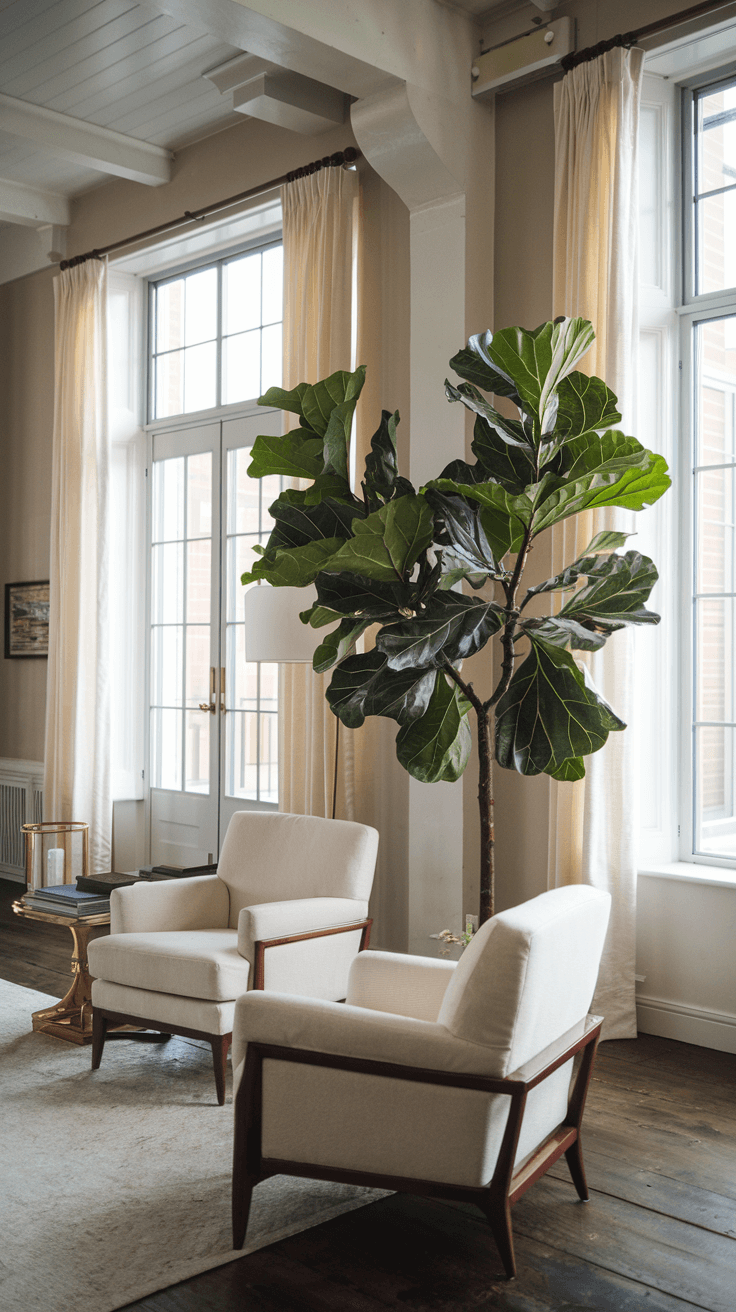
This increased humidity benefits skin, respiratory health, and even prevents wood furniture from drying and cracking.
Best for: Homes in dry climates or those with forced-air heating that depletes winter humidity, and anyone experiencing dry skin, irritated sinuses, or static electricity issues from low moisture levels.
Pro tip: Group multiple plants together to create a microclimate with noticeably higher humidity—the combined transpiration from several fiddles and companion plants amplifies the effect.
Quick implementation: Monitor the difference by placing a hygrometer near your fiddle and comparing readings to areas without plants. Most people notice 5-10% humidity increase within the plant’s immediate vicinity.
Impressive Visual Impact and Interior Design
The architectural quality of fiddle leaf figs makes them unparalleled focal points in interior spaces. Their large, violin-shaped leaves and vertical growth create dramatic visual interest that few other houseplants match.
A well-placed fiddle instantly elevates a room’s aesthetic, adding sophistication and organic texture.
Why it works: The bold, sculptural form of fiddles provides what designers call “visual weight”—they anchor a space and draw the eye upward, making rooms feel more finished and intentional. The deep green color complements virtually any color scheme, from minimalist whites to rich, saturated tones.
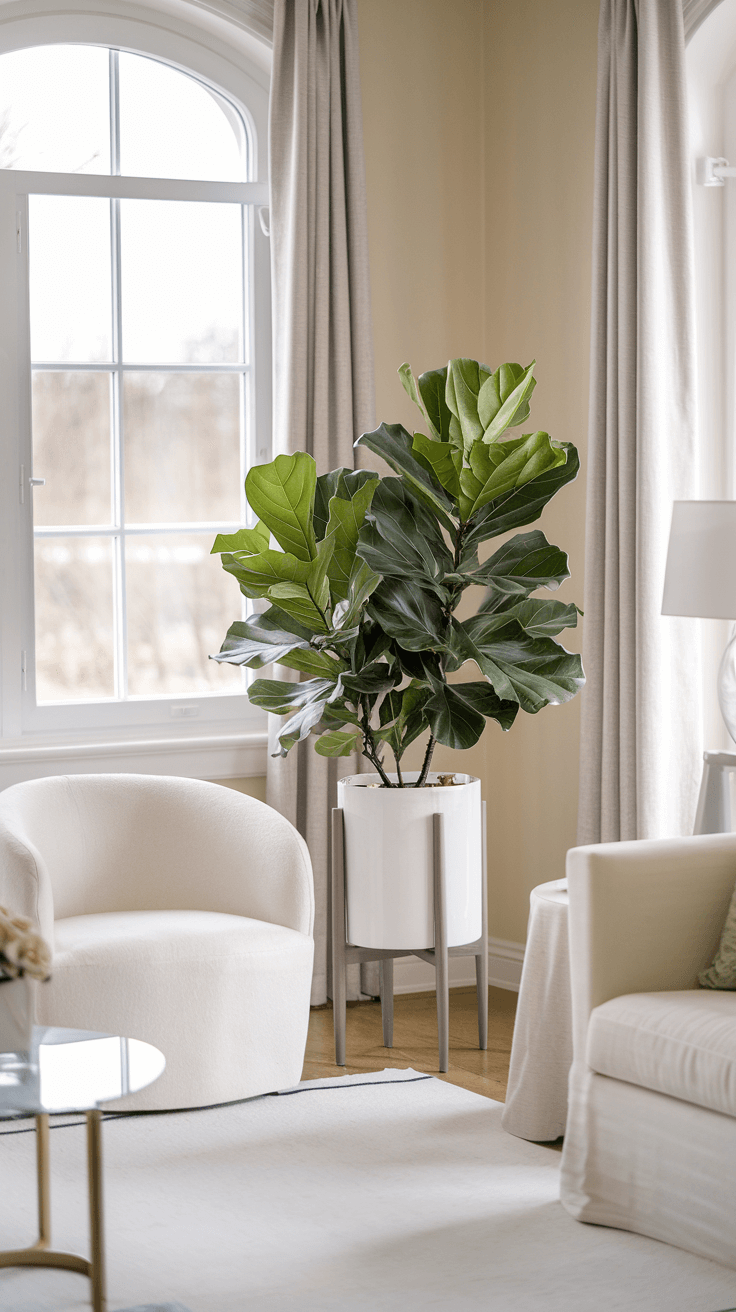
Best for: Corner spaces that feel empty, rooms needing vertical elements to balance horizontal furniture lines, and interiors seeking that modern-organic aesthetic popularized by contemporary design trends.
Pro tip: Use fiddles to define spaces in open floor plans—a large specimen creates a natural room divider that maintains sight lines while establishing distinct zones.
Quick implementation: Position your fiddle where it’s visible from multiple rooms or the main entrance, maximizing its impact as a signature design element throughout your home.
Stress Reduction and Mental Health Benefits
Caring for a fiddle leaf fig provides measurable psychological benefits through the simple act of nurturing a living thing. Research on horticultural therapy consistently shows that tending plants reduces cortisol levels, decreases anxiety, and improves overall mood.
The routine of checking soil moisture, wiping leaves, and observing growth creates meditative moments in busy schedules.
Why it works: The combination of gentle physical activity, connection with nature, and the satisfaction of watching something thrive under your care activates relaxation responses in the nervous system. The responsibility of plant care also provides purpose and structure, particularly valuable for those working from home or living alone.
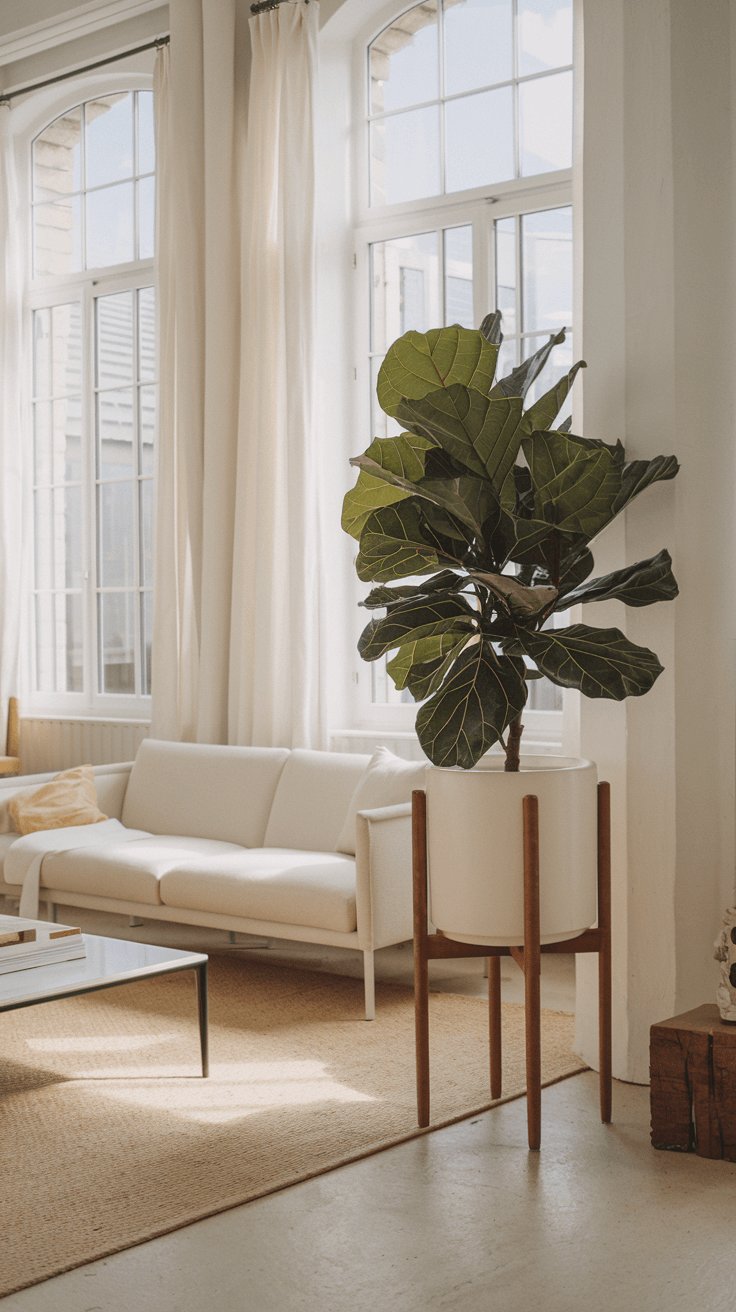
Best for: People experiencing work-related stress, those seeking mindfulness practices that feel natural rather than forced, and anyone wanting to incorporate more nature connection into urban living.
Pro tip: Establish a weekly “fiddle check-in” ritual where you thoroughly inspect your plant, wipe leaves, and assess needs. This structured interaction maximizes the meditative and stress-reducing benefits.
Quick implementation: When feeling overwhelmed, spend five minutes with your fiddle—checking soil, examining new growth, or simply sitting near it. The focused attention on something alive and growing provides mental reset.
Educational Opportunities and Skill Development
Maintaining a healthy fiddle leaf fig teaches valuable skills in observation, problem-solving, and patience.
These plants require attention to detail—learning to read subtle signs of overwatering versus underwatering, recognizing light deficiency, and understanding seasonal growth patterns develops keen diagnostic abilities that transfer to other areas of life.
Why it works: Fiddles are neither so easy they’re boring nor so difficult they’re discouraging. They occupy that sweet spot where success requires learning and adaptation, making the achievement of keeping one thriving genuinely rewarding. The challenges they present teach resilience and the value of adjusting approaches based on feedback.
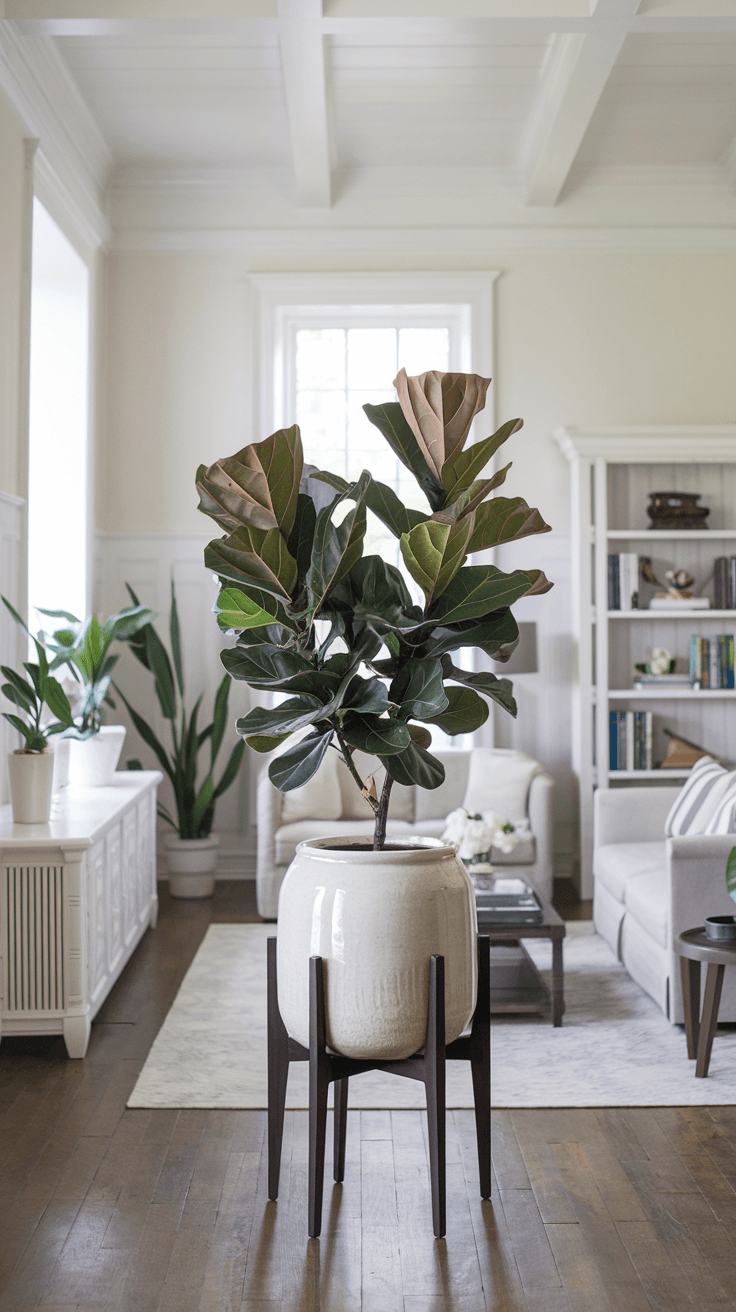
Best for: People who enjoy learning through direct experience, parents wanting to teach children responsibility and consequence, and anyone seeking a hobby that provides tangible progress and ongoing challenges.
Pro tip: Keep a simple journal tracking your fiddle’s care—watering dates, observations, problems, and solutions. Reviewing this record reveals patterns and documents your growing expertise over time.
Quick implementation: Research one specific aspect of fiddle care each month—light requirements, fertilization, pruning techniques—and implement what you learn, building comprehensive knowledge systematically.
Cost-Effective Long-Term Investment
Unlike cut flowers that last days or decorative items that go out of style, a fiddle leaf fig purchased as a young plant grows more impressive and valuable over years.
A $30 starter fiddle can develop into a six-foot specimen worth $200+ if purchased at that size, all while providing continuous benefits throughout its growth.
Why it works: Fiddles can live for decades with proper care, providing years of air purification, design impact, and psychological benefits from a single investment. As they mature, they often produce “pups” or can be propagated through cuttings, creating additional plants without further cost.
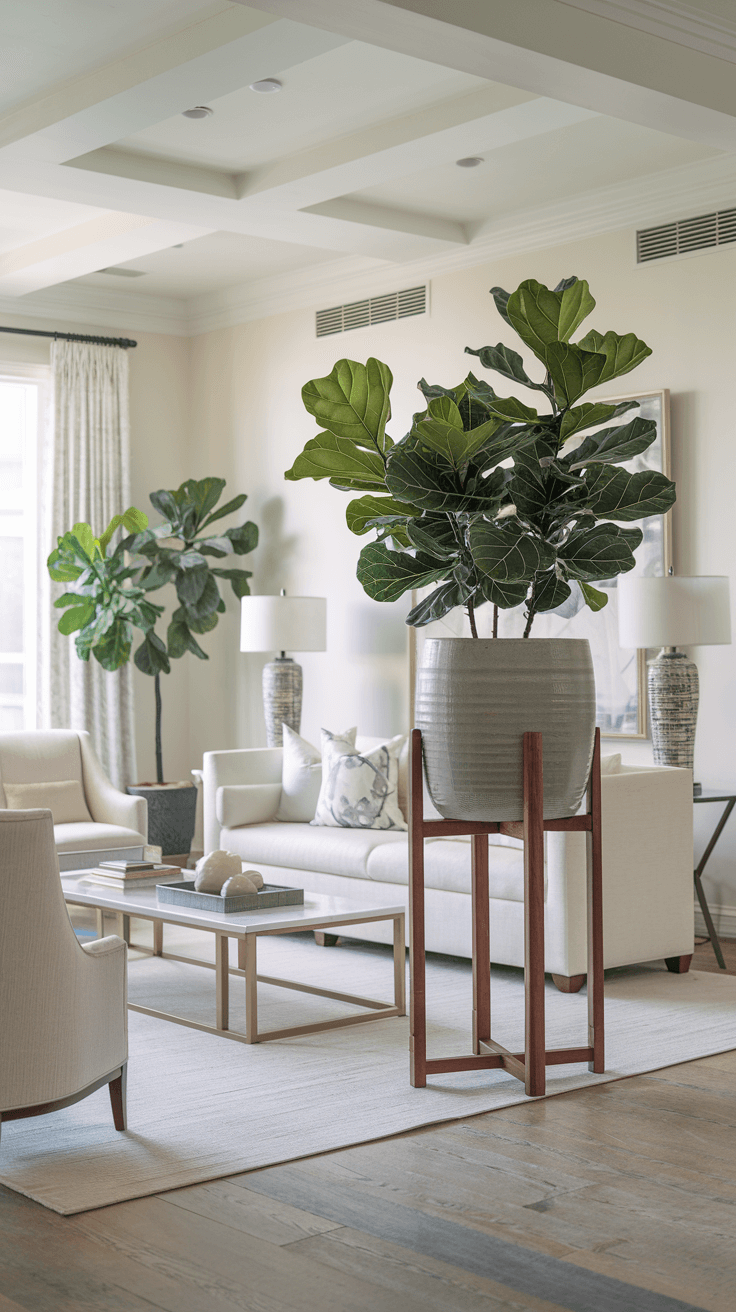
Best for: Budget-conscious decorators, renters who want to personalize spaces without permanent changes, and anyone seeking sustainable décor that appreciates rather than depreciates over time.
Pro tip: Buy young fiddles and focus on optimal care to encourage rapid growth. You’ll achieve the impressive size you want within 2-3 years at a fraction of the cost of purchasing mature specimens.
Quick implementation: Calculate the cost per year of your fiddle investment—a $40 plant providing benefits for 10+ years costs roughly $4 annually, making it extraordinarily economical compared to other home improvements.
Conversation Starter and Social Connection
A striking fiddle leaf fig naturally draws attention and comments from visitors, creating easy conversation opportunities.
People frequently ask about care requirements, share their own plant experiences, or express admiration, using your fiddle as a social bridge that might otherwise require more effort to establish.
Why it works: Plants provide neutral, positive topics that nearly everyone can engage with regardless of background or interests.
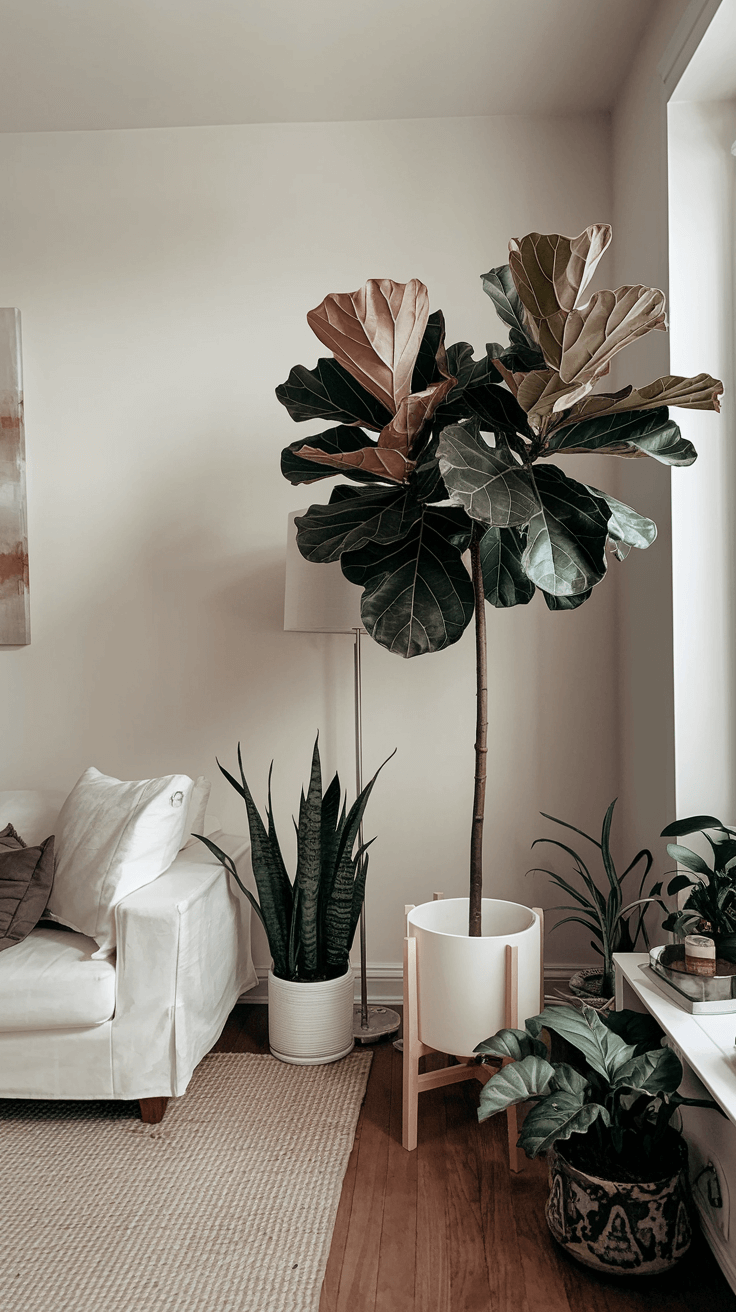
Sharing care tips, propagation successes, or even commiserating over challenges creates authentic connections between people who might otherwise struggle to find common ground.
Best for: Those who enjoy hosting, people working to build community in their neighborhoods, and anyone wanting to create welcoming environments that encourage interaction.
Pro tip: Join online fiddle leaf fig communities to expand your social circle beyond physical visitors—plant forums and social media groups provide supportive communities where you can share progress, seek advice, and celebrate successes.
Quick implementation: Take photos documenting your fiddle’s growth journey and share them when guests comment, turning casual observations into meaningful conversations about patience, care, and watching things develop.
Sense of Accomplishment and Pride
Successfully maintaining a thriving fiddle leaf fig provides genuine satisfaction and confidence. These plants have a reputation for being challenging, so keeping one healthy and growing creates legitimate pride in your accomplishment.
Watching new leaves unfurl every few weeks offers tangible evidence of your successful caregiving.
Why it works: The feedback loop of care and visible results reinforces competence and capability. Unlike many life challenges where outcomes remain ambiguous, a healthy fiddle provides unambiguous confirmation that you’re doing something right, boosting self-efficacy that extends beyond plant care.
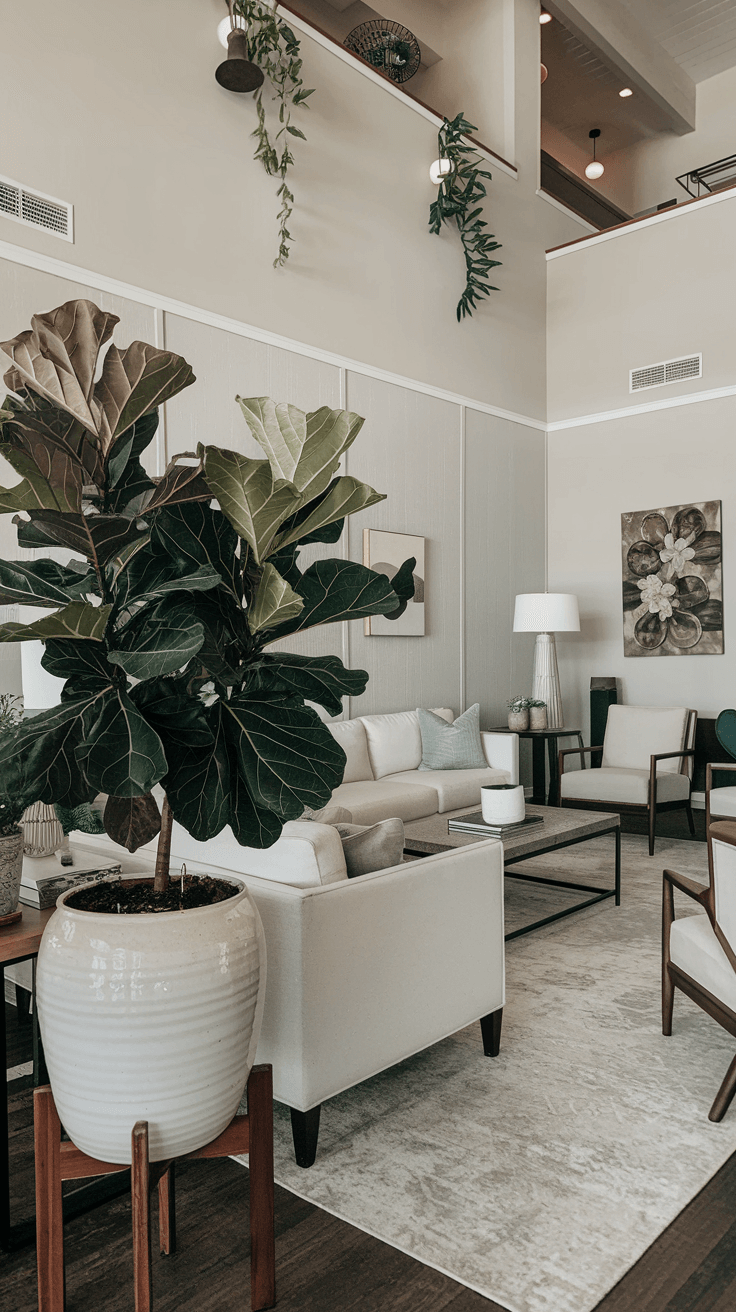
Best for: People recovering from setbacks, those building confidence in new skills, and anyone seeking hobbies that provide clear, measurable progress and achievement milestones.
Pro tip: Photograph your fiddle monthly from the same angle and distance, creating a visual timeline that makes growth obvious. Reviewing these images during difficult periods reminds you of your capability to nurture growth through consistent effort.
Quick implementation: Set specific goals for your fiddle—height targets, leaf counts, or successful propagation—and celebrate when you achieve them, acknowledging your developing expertise.
Better Sleep Quality
Placing a fiddle leaf fig in the bedroom contributes to improved sleep through multiple mechanisms—oxygen production, humidity regulation, and the psychological comfort of having living greenery in your sleep space.
The improved air quality and moisture levels create a more comfortable breathing environment throughout the night.
Why it works: Plants continue photosynthesis and oxygen release during daylight hours, and while this reverses slightly at night, the net effect in bedrooms is improved air quality.
The humidity they add prevents respiratory dryness that can disrupt sleep, and the visual presence of nature in sleeping areas has been linked to reduced anxiety and easier sleep onset.
Best for: People experiencing dry throat or nasal passages during sleep, those with difficulty falling asleep, and anyone wanting to create a more serene, nature-connected bedroom environment.
Pro tip: Position your bedroom fiddle where morning light will hit it first, allowing you to wake to the sight of sunlight filtering through those beautiful leaves—a gentle, natural way to start your day.
Quick implementation: Move an existing fiddle into your bedroom for two weeks and track any changes in sleep quality, morning congestion, or general comfort. Most people notice subtle improvements within a week.
Connection to Nature and Biophilic Benefits
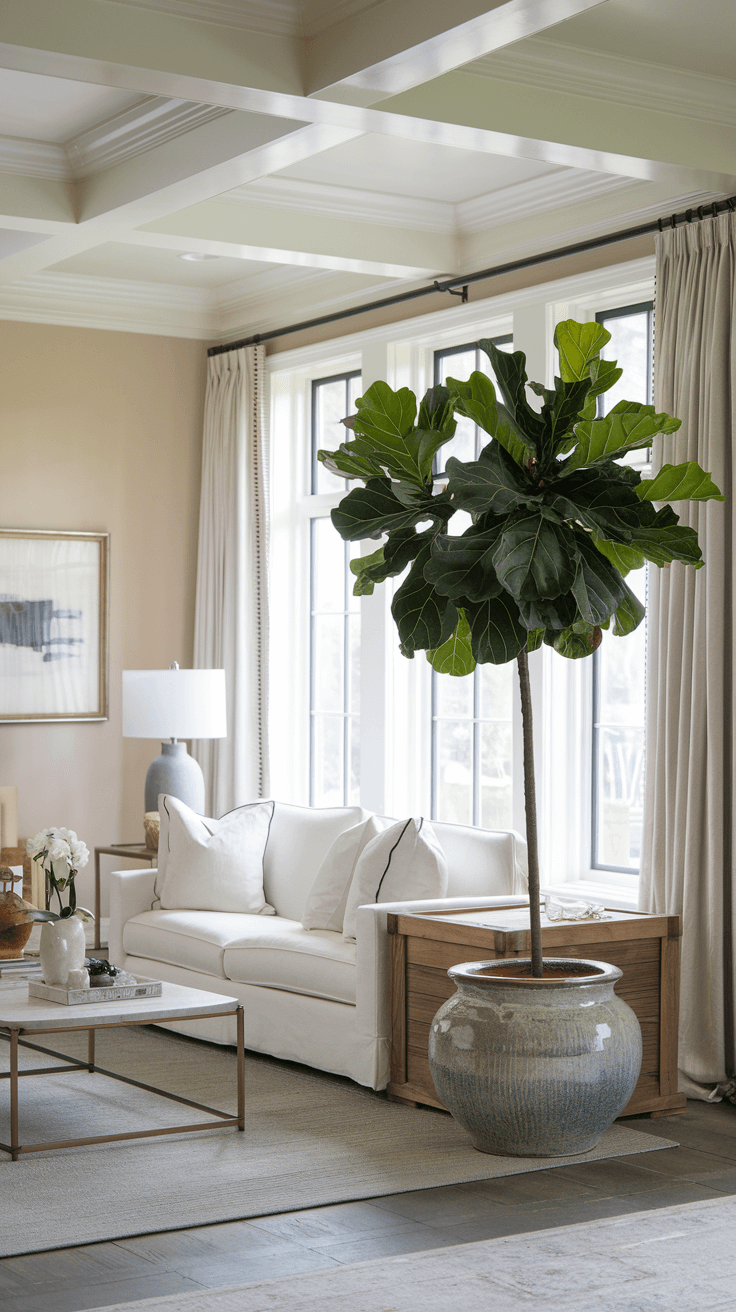
Fiddle leaf figs bring a piece of nature into spaces where direct outdoor connection is limited. This satisfies biophilia—the innate human tendency to seek connection with nature—even in urban apartments or offices far removed from natural environments.
The presence of a living, growing plant provides sensory and psychological benefits that artificial décor cannot replicate.
Why it works: Humans evolved in natural environments and maintain psychological needs for nature contact even in modern settings. Having substantial plants like fiddles in living spaces partially fulfills this need, reducing the stress and disconnection that purely artificial environments create.
The daily interaction with a living system grounds us in natural rhythms.
Best for: Urban dwellers with limited access to gardens or parks, people working from home who rarely venture outdoors, and anyone feeling disconnected from nature despite recognizing its importance to wellbeing.
Pro tip: Combine your fiddle with other plants of varying sizes and textures to create an indoor “nature corner” that amplifies biophilic benefits through greater diversity and visual complexity.
Quick implementation: Spend five minutes daily in direct contact with your fiddle—not just passing by, but deliberately observing it, touching leaves, and noticing details. This intentional nature connection provides psychological benefits beyond the plant’s passive presence.
Bringing It All Together
The benefits of keeping a fiddle leaf fig extend far beyond their Instagram-worthy appearance into tangible improvements in air quality, mental health, and daily living environment.
These plants work continuously to purify air, regulate humidity, and create visually stunning focal points while simultaneously offering owners opportunities for stress reduction, skill development, and nature connection.
The initial investment in a fiddle—whether financial or the time required to learn proper care—returns dividends across multiple dimensions of home and life quality.
For those intimidated by their reputation for being finicky, remember that thousands of successful fiddle owners started exactly where you are, uncertain but willing to learn.
The challenges these plants present are part of their value, creating opportunities for growth in both the plant and the grower.
Whether you’re drawn to fiddles for their dramatic aesthetic impact or curious about the health benefits they provide, adding one to your home represents a decision to invest in a living element that contributes actively to your space rather than simply occupying it.
The relationship you develop with your fiddle—learning its needs, celebrating its growth, and solving the occasional problem—becomes part of the benefit itself, adding richness and connection to daily life in ways both measurable and beautifully intangible.

